So you want to know more about optical fibre?
This section tells you all about optical fibres; what they are made of, how they work, the different types, where they are used and how they are made.
What is it made of?
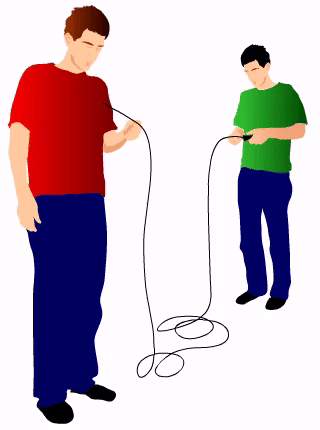
An optical fibre is a solid rod of transparent material, which can be as fine as a strand of human hair, designed to efficiently guide light from one place to another.

The most common raw material for making optical fibres is very pure silica sand. This is used because it is relatively inexpensive and can be formed into a glass so pure that a solid block 35 kilometres thick would be as transparent as a pristine clean windowpane. Ordinary glass would lose the signal beyond recovery within a few metres, as the impurities would scatter the light in the fibre like light lost in fog.
How does it work?
So what stops the light from leaking out as it travels along an optical fibre? This is down to physics and something called total internal reflection (TIR).
All transparent materials have a property known as refractive index, which is simply a measure of how much light is bent when passing through the surface of the material. When light passes from a higher to a lower refractive index material, some of the light passes through and some is reflected. As the incident angle reaches what is known as the critical angle, all the light is reflected (TIR!).
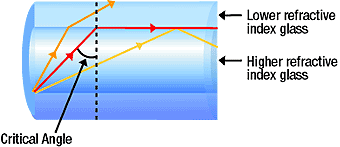
A fibre is constructed with a central core of slightly higher refractive index relative to the surrounding cladding.
Any light that enters the fibre core at a shallow enough angle will be trapped in the core and guided until it reaches the far end (or a tight bend!).
How is it constructed?
A standard optical fibre usually has a cladding diameter of about an eighth of a millimetre (or 125µm).
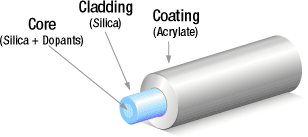
As you can imagine a strand of glass so thin is very fragile so to make sure that the fibres do not get damaged they need protecting.
To protect the fibre it is usually covered with one or two plastic coatings. The primary coating is normally made of acrylate and is usually about 0.25 mm in diameter. This allows the fibre to bend without breaking. A secondary coating of about 1-2 mm diameter is sometimes used to provide additional protection. This may be a tight-buffering or loose tubing (where the fibre is not mechanically bonded to tube).
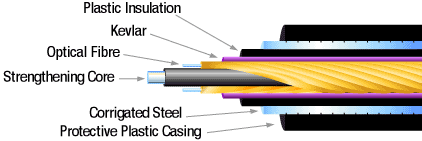
When many fibres are being cabled up together to be installed in the ground then they are usually “stranded” around a central strength member and additional armouring is applied to the finished cable (to protect it from the men who dig up the road!)
What are the different types of fibre?
You will hear people talking about singlemode and multimode fibre. So what is the difference?
Light efficiently travels down a fibre only when the distance between each reflection point is a whole number of its wavelengths. Therefore only certain paths, or modes, are able to transmit light successfully.
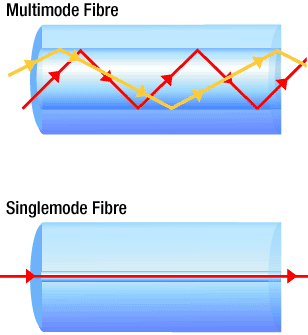
In multimode fibre the core diameter is about half that of its cladding (typically 50 µm or 62.5 µm). This means there are several modes or paths available for the light to travel down the fibre. Each of these modes has a different path length. Therefore, as the light travels down the fibre, the higher order modes start to fall behind the lower order modes (the ones nearly travelling straight down the centre of the fibre). A sharp pulse at the beginning of the fibre becomes spread out and less distinct. This is called modal dispersion and limits how close pulses can be transmitted together (called the data rate) before they merge together and information gets lost.
In singlemode fibre the core is made so small (about 10 µm!) that only a single light path (a “single mode”) can successfully propagate. This means that there is no modal dispersion, so much higher data rates can be achieved. However the small core means that it is harder (and more expensive) to reliably connect or join singlemode compared to multimode fibre.
What is it used for?
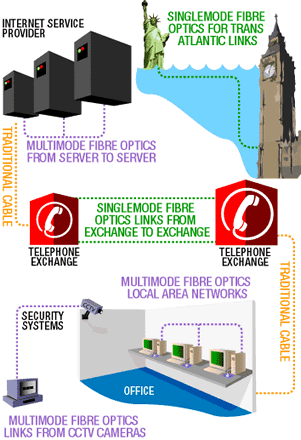
The properties of optical fibre make it ideal for many applications. Bundles of fibres can be used for lighting inaccessible areas (or making table decorations), or for medical endoscopes. Fibres that are sensitive to environmental changes such as temperature can be used as sensors.
However, by far the largest use of optical fibre is for communications. By sending pulses of light from a source at one end of the fibre to a detector at the other, information or digitised voice and video can be transmitted great distances.
Nowadays, when you make a phone call, the sound of your voice will almost certainly have been digitised and converted into light to travel, for at least part of its journey, down an optical fibre. Subsea optical fibre cables link all the continents of the world, in most developed countries all trunk routes (between exchanges) are now cabled with optical fibre.
These telecommunication applications require lots of information (high bandwidth) to be sent long distances so singlemode fibre (with its low modal dispersion) tends to be used for these applications.
As computers process information faster the networks that link them need to work faster. Increasingly, fibre is being used within computer local area networks (LANs) to help speed the transfer of information between workstations. These datacommunication connections usually have lower bandwidth requirements over shorter distances enabling multimode fibre to be used in these applications.
Why is fibre used instead of copper?
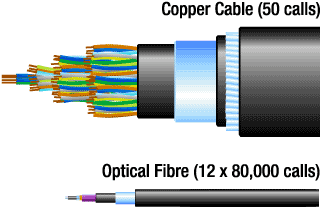
When your voice is digitised, or a file is transferred from computer to computer, the result is a stream of 1s and 0s, which could be transmitted from point to point in any way. Possible transmission methods include optical (through free space or fibre), radio and microwave, and electrical.
Where a cable is to be used, the choice is between electrical transmission over copper, and optical transmission over fibre. Although optical transmission involves additional equipment to convert electrical signals to optical and back again, it has several advantages which lead to its increasing use in many applications.
Fibre’s high bandwidth means the more data can be transmitted further, so use for long-haul telecommunications is almost standard these days (a pair of copper wires can transmit 2 telephone calls simultaneously – a single fibre over 80,000!).
Glass is cheaper than copper so for the same data carrying capability fibre cables cost far less than copper cables.
Fibre is unaffected by electro-magnetic interference, and so is ideal in electrically noisy environments.
No electrical current is transmitted down a fibre (glass is a good insulator!), so it is suitable in hazardous environments where electrical discharge would be a potential disaster.
No signal is radiated by a fibre (unless you bend it or break into it), making an all-fibre network secure from undetectable tampering.
As transmission technology continues to improve, higher and higher bandwidths are possible over the same fibre links without having to replace the cables.
How is the fibre made?
An optical fibre is typically only 125 µm in diameter, and has a core of a different refractive index running exactly down its centre. However, it starts life as a rod of solid glass about 25 mm in diameter and about 1 metre in length. This is called a preform and is an exactly scaled up version of the core and cladding of the final fibre.
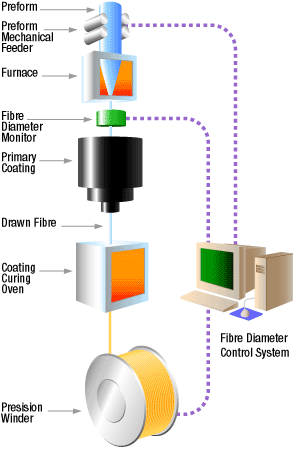
The preform is usually made using a process called modified chemical vapour deposition (MCVD).
A cylinder of pure silica is spun in a special lathe, and heated from the outside. Meanwhile, a vapour created by forcing oxygen through solutions of silica and dopant is sprayed on the inside of the cylinder. The heat causes the glass to deposit on the inside of the cylinder, building the core of the preform inwards. The level of dopant can be tightly controlled to create the desired refractive index profile. Finally the cylinder is collapsed to form the preform rod
The fibre itself is drawn from the preform, which is loaded at the top of a fibre drawing tower and heated to about 2050°C. The fibre diameter is monitored as it is drawn, and the speed of drawing adjusted to keep the diameter constant. As the fibre cools, it is also fed through coating cups to apply the required buffer coatings, which are cured in ultraviolet ovens, before the coated fibre is wound onto spools.
See our other FAQ sections: What is Fusion Splicing? and What is FASE?
 Tritec
Tritec